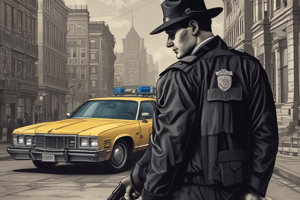Podcast
Questions and Answers
What does code 187(a) represent?
What does code 187(a) represent?
- Robbery
- Homicide / Murder (correct)
- Assault
- Carjacking
Which code signifies Robbery?
Which code signifies Robbery?
- 215(a)
- 240
- 242
- 211 (correct)
What does code 215(a) indicate?
What does code 215(a) indicate?
- Burglary
- Carjacking (correct)
- Assault with a Deadly Weapon
- Assault
What is the definition of code 240?
What is the definition of code 240?
What does code 261 represent?
What does code 261 represent?
Code 459 refers to which crime?
Code 459 refers to which crime?
What is the crime associated with code 484?
What is the crime associated with code 484?
What does code 602 indicate?
What does code 602 indicate?
What does code 647(f) refer to?
What does code 647(f) refer to?
What does code 5150 describe?
What does code 5150 describe?
What is the significance of code 10-7?
What is the significance of code 10-7?
Study Notes
Criminal Offenses
- Homicide / Murder (187(a)): Unlawful killing of a human with malice aforethought, classified as a felony.
- Robbery (211): Taking personal property from another by force or fear, categorized as a felony.
- Carjacking (215(a)): Taking a motor vehicle from another by force or fear, considered a felony.
- Assault (240): Attempting to commit violent injury on another person, requires ability to do so, classified as a misdemeanor.
- Battery (242): Willful use of force or violence upon another person, can be misdemeanor or felony.
- Assault with a Deadly Weapon NON FIREARM (245(a)(1)): Assault using a deadly weapon without a firearm, likely to cause great bodily injury, a felony.
- Rape (261): Sexual intercourse without consent, through force or fear, categorized as a felony.
- Disturbing the Peace (415): Unlawful fighting or maliciously disturbing others with loud noise or offensive words, classified as a misdemeanor.
- Arson (451): Willfully and maliciously causing fire to a structure or property, classified as a felony.
- Burglary (459): Entering a structure with intent to commit theft or another felony, categorized as a felony.
- Theft / Larceny (484): Stealing property of another, categorized as misdemeanor or felony.
- Grand Theft (487): Theft of property valued over $400, classified as a felony.
- Petty Theft (488): Theft of property valued at $400 or less, categorized as a misdemeanor.
- Trespass (602): Willful entry onto another person's land without permission, classified as a misdemeanor.
- Disorderly Conduct / Drunk in Public (647(f)): Engaging in lewd conduct or being drunk in a way that endangers safety in public, categorized as a misdemeanor.
- Resisting Peace Officers (148(a)(1)): Obstructing a peace officer in their duties, classified as a misdemeanor.
- Giving False Information (148.9(a)): Falsely representing oneself to a peace officer during an arrest or detention, classified as a misdemeanor.
Police Codes
- Reception Poor (10-1): Indicates poor communication reception.
- Suspect in custody (10-15): Confirms that a suspect is detained.
- Reception Good (10-2): Indicates clear communication reception.
- Message Received (10-4): Acknowledgment of message receipt.
- Arrived on scene (10-97): Confirmation that an officer is at the location.
- Relay (10-5): Instruction to pass on a message.
- Busy (10-6): Indicates that an officer is occupied.
- Out of Service (10-7): Officer is no longer available for duty.
- In Service (10-8): Officer is ready and active for duty.
- Assault on a Peace Officer (241(b)): Assaulting a law enforcement officer, classified as a misdemeanor.
- Battery on a Peace Officer (243(b)): Battery against a law enforcement officer, categorized as a misdemeanor.
- Prowling (647(h)): Suspicious behavior that may indicate intent to commit a crime, classified as a misdemeanor.
- Statutory Rape (261.5(b)): Sexual intercourse with a minor with a close age difference, categorized as misdemeanor.
Vehicle Codes
- Stolen Vehicle (10851(a)): Theft of a vehicle.
- Driving without a license (12500(a)): Operating a vehicle without a valid driver’s license, classified as a misdemeanor.
- Hit and run with Injuries (20001(a)): Leaving the scene of an accident causing injury, categorized as a felony.
- Hit and run with property damage only (20002(a)): Leaving the scene of an accident causing property damage, classified as a misdemeanor.
Other Criminal Acts
- Shooting at a dwelling or vehicle (246): Firing at occupied structures or vehicles, categorized as a felony.
- Indecent Exposure (314): Exposing oneself in public inappropriately, classified as a misdemeanor.
- Mentally Disturbed Person (5150): Individual harmful to self or others or unable to care for themselves, categorized under welfare institutions.
- Attempted something... (664): Refers to the attempt of committing a crime.
- Assault with a Deadly Weapon WITH FIREARM (245(a)(2)): Assault using a firearm or deadly weapon, likely to cause great injury, categorized as a felony.
Studying That Suits You
Use AI to generate personalized quizzes and flashcards to suit your learning preferences.
Description
Test your knowledge on California police codes with these flashcards. Each card features a specific code alongside its definition, helping you to understand various laws such as homicide, robbery, and assault. Perfect for law enforcement professionals or students of criminal justice.




